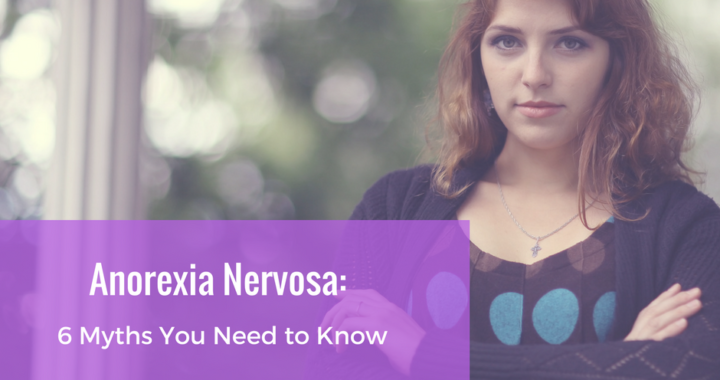When you think of Anorexia Nervosa what often comes to mind is a young emaciated girl. These images are what we see in the popular media. Unfortunately, these images are misleading and confusing. Media images contribute to myths about anorexia nervosa and what it really is and “looks” like. Below there are several common myths debunked about the disorder
What is Anorexia Nervosa?
Anorexia Nervosa is characterized by an intense fear of being fat (or gaining weight) despite being at a low weight, having a low caloric intake which leads to weight loss or poor weight gain/growth in children and the inability to evaluate own body size and shape. Meaning the sufferer thinks their body is larger that it is.
According to the National Eating Disorder Association, 0.9% to 2% of women and 0.1% to 0.3% of men will experience Anorexia Nervosa in their lifetime. Below you will find six common myths about anorexia nervosa.
Myth: Anorexia Nervosa is just a phase.
Fact: Anorexia nervosa is a serious and life-threatening disorder. If left untreated it can cause low blood sugar, loss of bone mass, kidney & liver damage, depression, anemia, infertility, cardiac arrest and even death. It is the leading cause of death among all mental health conditions. Anorexia nervosa must be treated by an experienced healthcare team in order to avoid and reduce complications associated with it.
Myth: Anorexia Nervosa is all about food.
Fact: Initially it may have seemed that the anorexia started with food restriction, but it really is NOT just about food. That is to say, people simply can’t just eat to get over the disorder. The disorder helps the sufferer to cope with life struggles, despite it being damaging to the body. Eating disorders serve to help the sufferers with low self-esteem, poor self-worth, reduce anxiety, strive for perfection, increase control, and who have problems expressing feelings or setting boundaries. For example, some develop an eating disorder leading up to going off to college for the first time. In this example, the eating disorder “helps” the sufferer to manage the transition to college. One goal of therapy for those with eating disorders is to learn healthy coping skills, so the sufferer won’t need to use the eating disorder to help manage their life.
Furthermore, eating disorders co-occur with other mental health disorders including anxiety disorders, depression, post-traumatic stress disorder, ADHD and/or personality disorders. Both the eating disorder and the co-occurring disorders must be treated in order for full recovery.
Myth: Anorexia nervosa only happens to adolescent girls.
Fact: While anorexia nervosa most commonly occurs in young girls particularly around puberty, it does occur in males and adults. According to The National Eating Disorder Association, about 25% of the people who have anorexia nervosa are males. According to the National Association of Anorexia & Associated Disorders, 13% of women over the age of 50 engage in eating disorder behaviors.
Myth: You can recover from Anorexia Nervosa on your own, without treatment from professionals.
Fact: Those suffering from the disease need to get treatment to recover. According to the National Association of Anorexia & Associated Disorders 30% of those who don’t get treatment will die. While the mortality rate for those who get adequate treatment falls to 2-3%. Of those sufferers that do seek treatment about 60% fully recover.
Adequate and early treatment is important. A doctor, counselor, dietitian and psychiatrist are usually all members of the treatment team. Having clinicians that are experienced in treating eating disorders is a must.
Myth: Bad parenting causes Anorexia Nervosa
Fact: There is no single cause of anorexia nervosa. According to the National Eating Disorder Association, there are several risk factors for developing an eating disorder including body dissatisfaction, drive for thinness, dieting, being female, poor or low mood and psychosocial stressors. Family history of eating disorders, genetic factors, certain temperaments, family & social stress, perfectionism, low self-esteem and co-occurring mental health disorders are all other risk factors associated with eating disorders.
There is no single thing or person to “blame” for the eating disorder. Furthermore, treatment of the eating disorder may not uncover all of its causes, the most important thing is to get adequate & early treatment for the eating disorder.
Myth: You can tell by looking at someone that they have Anorexia Nervosa.
Fact: Although one of the characteristics of anorexia nervosa is low body weight, one does not have to look emaciated to meet the diagnostic criteria. People who look like they have a “normal” weight may very well be struggling with the disorder.
Weight loss or low weight is one sign of anorexia nervosa, but other signs include refusal to eat, food rituals (cutting up food into small pieces, moving food around plate without eating, chewing food & spitting it out, etc.), eliminating certain types of food out of the diet, skipping meals, eating the same types of food over and over again, refusal to eat with others, spending large amounts of time looking at recipes & cooking large meals for others and not eating what was cooked and body image distortion & drive for thinness. To learn more about the signs & symptoms visit:
If you are suffering from anorexia nervosa or a loved one has an eating disorder
1. Have hope. Eating disorders are treatable.
2. Seek professional treatment from an experienced eating disorder healthcare professionals. Eating disorders won’t go away on their own.
3. Educate yourself about eating disorders. Resources include the National Eating Disorder Association, Anorexia Nervosa & Related Disorders Association, The Eating Disorder Sourcebook by Carolyn Costin.
If you live in the Austin, TX area please call me for a consultation at (512) 293-5770.


